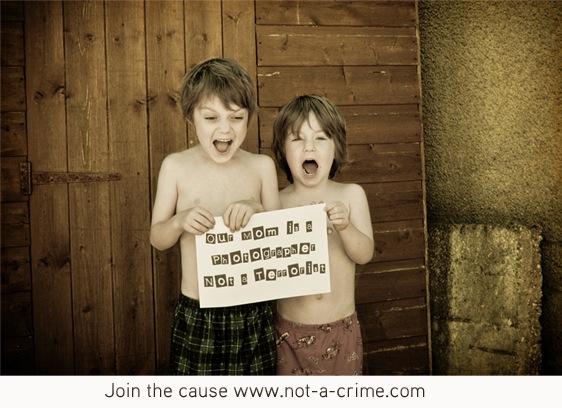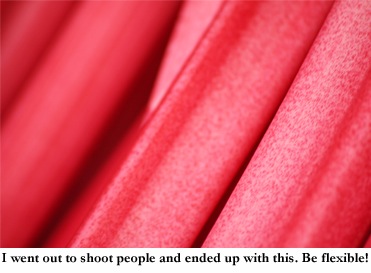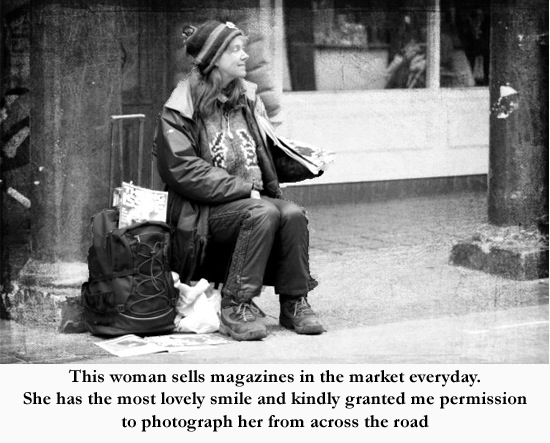A Guest Post by Elizabeth Halford.
Would you believe that in the UK, anti-terrorism laws include bits for photographers?
These days, photographers are routinely made to feel like terrorists. Highly suspect criminal characters who must be watched closely. Case in point? Picture me walking around the Winchester Saturday market taking macro photography of the fruit & veg stalls…followed by two police officers (see the dangerous photo in this post). It happened. Seriously. Another example? Trying to photograph my son’s baptism in a privately rented swimming pool and being denied because it was ‘against child protection laws’. My son’s baptism! Once in a lifetime event, people!

In England, the new anti terrorism legislation and child protection laws cover all manner of photographic sin and is what prevents photographers going about their business in a dignified fashion. Which brings me to tip numero uno:
1.) KNOW YOUR RIGHTS
Empower yourself and be confident in your rights as a photographer. Take some time to look up the law in your country. Oh, look! I’ve done it for you (I’m so nice!): UK, America, Australia. There are PDF pocket guides which I have printed and stuffed in my camera bag. If some uninformed police officer, annoyed citizen, concerned parent, parking meter maid (get the point?) approaches you and asks you to ‘put the weapon down slowly!’ you can roll your eyes, hand them a little piece of paper and be on your way. Ok…I don’t recommend rolling your eyes as a police officer.
2.) BE PREPARED
Even if I’m not going out for the purpose of capturing life outside the dark room, I still have my camera on me. You never know what you might encounter out in the world. And on the subject of being prepared, check and re-check that you have everything you need for your adventure. I often get overly confident and think I’ve got everything only to get to a shoot without memory cards or, most recently, get to London for my photography weekend with cameras and NO LENSES! Talk about depressing! Put a post-it on the door to remind you to re-check that you have everything.

3.) ADMIRE OTHERS
There are so so many amazing, inspiring photographers in history whose art was photographing strangers. My favourite is Henri Cartier-Bresson. Look at their work often and remind yourself that if they hadn’t taken those photographs, those moments in history, however meaningless they may seem, would have been lost forever. Photographers are not criminals, rather, we are heroes! We have the power to stop time. We hold in our grasp the power to preserve a moment for eternity. Be confident in that fact.
4.) BE REALISTIC AND FLEXIBLE
I could go out shooting for an entire day and end up with only one or two ‘keepers’. As in any type of photography, just shoot shoot shoot and see what you end up with at the end. I often go out with the goal of shooting one thing (perhaps an old couple holding hands on a bench) and come home with a cracking good shot of rhubarb. Be flexible and just let the day, the sights, the smells and the opportunities lead you. Don’t manipulate - let fate decide what the day brings and just document what you find.

5.) DISCONNECT
Sunglasses and an ipod. I use them to disconnect from my surroundings. This one is a double-edged sword, though. One the one hand, according to tip 4, I like to let my surroundings guide me and determine what happens. However, when you feel conscious of nosey people whispering or even the police who will harass you while you’re operating well within your rights, it’s nice to just disconnect. Glasses can impair your viewfinder skills, but I like to look around without people knowing I’m looking at them and if the police see you seeing them, then you sort of have to pack up and move on. I’m at an advantage in the UK where often, ‘good manners’ dictate how people interact with you. Even if they hate your guts for taking photos, they will usually be too timid to say so, especially if they can’t just shout because you’re listening to music (even if you have nothing playing!) Even the police are timid to tap you on the shoulder. I don’t know how that works in America, but I’d venture to say that people are less suspicious there and generally in a better mood.
6.) JUST BE POLITE
Obviously, be polite and use common sense. I never shoot children without parental permission. You really don’t want to mess with a mother bear and her cubs. Even when I’m photographing my own children, if another kid comes nearby or starts playing with mine, I put my camera down. It’s just common courtesy and besides, the law forbids you from taking photos of kids without consent.
7.) TRY TO BE A WOMAN
This might be the most difficult tip for some. Try your best to just be a woman! I am so blessed to be a female photographer. We are generally regarded less dangerous and people treat us differently. If someone freezes in their tracks when you pull out your camera (I mean cm’on they’re dangerous!) just smile sweetly and continue on in your photographing.
8.) ASK FIRST
I really have a passion for photographing the more seedy side of life. I often approach a homeless person or the most downtrodden looking guy drinking at 11am and simply ask. I usually say ‘hi, I’m a photographer may I take your photo?’ They’ve never said no. I back up to the other side of the street and just wait until they forget I’m there. And for goodness sake, buy ‘em a cup of coffee!

9.) HAVE A REASONABLE EXPECTATION
In tip 1, there are links to sites to find the law in your country. There’s this thing called a ‘reasonable expectation of privacy’ which we don’t generally have when we’re out in public. It’s not reasonable to believe that you have privacy when you’re sitting on the street playing an instrument for money or walking around Disney World. Feel free to photograph just about everything you see out in public. I mean…it’s called ‘public’ for a reason, eh?
10.) SAFETY IN NUMBERS
New to photographing in public? Go with a friend. Go places where there are other photographers. Go to a city or tourist attraction where everyone has a camera around their neck! You will just blend into the throngs of fellow photographers. For me, this also creates a pretty cool challenge - photograph popular places in a completely different way than everyone else. Google “Disney Castle” or something and all the photos will look the same. Try to capture it in an original way.
So my last thought to you? I will stand on the roof and proclaim “Photographers young and old! Professional and hobby! Compact lovers and SLR owners! BE BRAVE AND BOLD! YOU HAVE THE POWER TO FREEZE TIME FOR ETERNITY!”
About the Author:  Elizabeth Halford began her photography career by stalking her three kids six years ago and has since moved on to other people’s children.
Elizabeth Halford began her photography career by stalking her three kids six years ago and has since moved on to other people’s children.
She owns a lifestyle portrait studio in Hampshire, England. See more of Elizabeth’s work at www.elizabethhalford.com.
Post from: Digital Photography School - Photography Tips.
I’m a Photographer, Not a Terrorist - How to Shoot in Public With Confidence
Comentaris
Publica un comentari a l'entrada